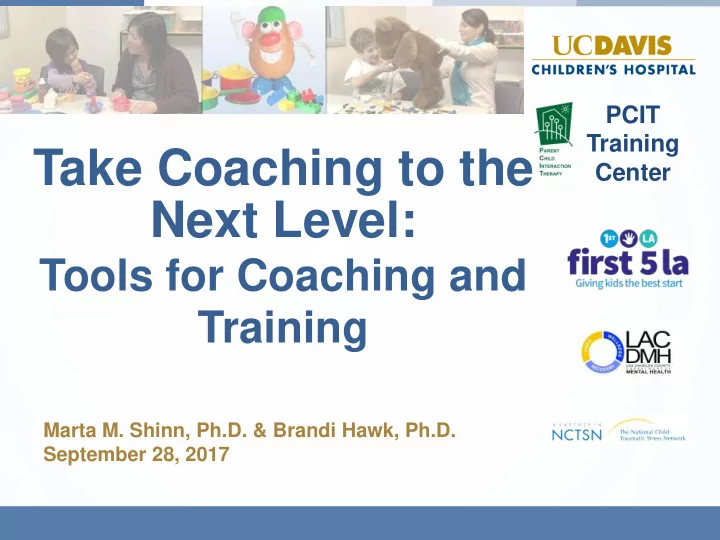

PCIT Training Take Coaching to the Center Next Level: Tools for Coaching and Training Marta M. Shinn, Ph.D. & Brandi Hawk, Ph.D. September 28, 2017
Coaching Why do we talk about it so much? Coaching is one of the primary tools used in PCIT. • We Know that PRIDE skills, Selective Attention, Direct Commands, & TO are effective. • BUT without coaching, our parents might not use them effectively • We Know the mastery criteria and that parental mastery is related to better child behaviors. • BUT without coaching, our parents will likely never meet mastery – It’s Hard! • We Know why parents should use the skills & can see the effects of using the skills. • BUT without effective coaching with all three levels, our parents can feel frustrated that they are expected to perform rather than their children.
Assessing Coaching How do we measure effective coaching? • Coach Coding • Coding of therapist verbalizations • ToT Session Checklist • Trainers complete 5-min coach coding every session • Therapists can review videos and coach code themselves • Assessment of Therapist Coaching • Qualitative assessment of therapist coaching • Trainers complete periodically to provide more holistic feedback to trainees • Therapists can review videos and assess themselves
Coach Coding Review of Categories • Level One: Lead • Therapist tells the parent to do something • Can be line feeding or open ended • Level Two: Follow • Therapist reinforces parent’s use of skills • Can be acknowledgement or praise • Errors = mislabeling a verbalization • Missed Opportunities = not acknowledging a verbalization • Level Three: Explain • Therapist helps parent understand why to use skills, how they impact behavior, and how to use them elsewhere • Explanation = why to use skill, developmental expectations • Observation = describe child behaviors, parent behaviors, changes in parent- child relationship • Generalization = explain how to use skill in real-life situations, explain how child behaviors generalize
Coach Coding Time-Out Sequence. This is in addition to regular coding. • Level One: Lead • Therapist leads the parent through time-out sequence • DC = direct commands used to lead • IC/LF = indirect commands OR line feeding used to lead • Praise/encourage parent through sequence • Therapist reinforces parent’s use of each step of time-out sequence • Gentle correction • Therapist ensures parent uses time-out sequence accurately by correcting parent’s incorrect phrasing or other mistakes
ATC Assessment of Therapist Coaching (Form 4.19 in Trainer Manual) Throughout coaching, how well did the therapist show… • Sensitivity • Parent response to coaching • Rewarding and effective coaching • Warmth • Genuine, warm, unconditional positive regard • Pace & Flow • Coaching is timed well and uses three levels of coaching appropriately • Knowledge • Effective coaching of TO and ignore • Accurate and appropriate Level Two and Three statements • Treatment Fidelity • Maintains focus on treatment goals • Codes and coaches according to PCIT standards
ATC Assessment of Therapist Coaching (Form 4.19 in Trainer Manual)
Practice!! Coach code during video. Complete ATC after video. •Client is in CDI. AU Session 1 Video
Discuss • Coach Coding • Level One, Two, Three • Missed opportunities or errors? • What types of Level 3? • ATC • Areas of strength? • Areas for growth?
Practice!! Coach code during video. Complete ATC after video. •Client is in CDI. KA Session 1 Video
Discuss • Coach Coding • Level One, Two, Three • Missed opportunities or errors? • What types of Level 3? •ATC • Areas of strength? • Areas for growth?
Practice!! Coach code during video. Complete ATC after video. •Client is in PDI. • Remember to complete time-out sequence coach coding AND regular coach coding PDI coach coding Video
Discuss • Coach Coding • Level One, Two, Three • Missed opportunities or errors? • What types of Level 3? • Time-out sequence coding? • ATC • Areas of strength? • Areas for growth?
Training Practice! Coach code during video. Complete ATC after video. • Imagine you are this therapist’s trainer. • This is the therapist’s FIRST TIME COACHING. Z Session 1 Video
Discuss • Coach Coding • Level One, Two, Three • Missed opportunities or errors? • What types of Level 3? • ATC • Areas of strength? • Areas for growth? • As a trainer… • What feedback do you give? • What do you want your trainee to work on for next session?
Wrap-Up Coaching is Important! Both the types of verbalizations and the qualitative aspects of coaching. It is important for therapists to evaluate their own coaching, and for trainers to effectively evaluate trainees’ coaching. • Questions??? • Coach coding • ATC • Training • Anything
CONTACT US Website: pcit.ucdavis.edu Web Course: pcit.ucdavis.edu/pcit-web-course Email: bhawk@ucdavis.edu mshinn@cgcinc.org www.facebook.com/UCDPCIT PCIT LinkedIn Group
THANK YOU! Thanks for your interest in UC Davis PCIT Training.
Recommend
More recommend